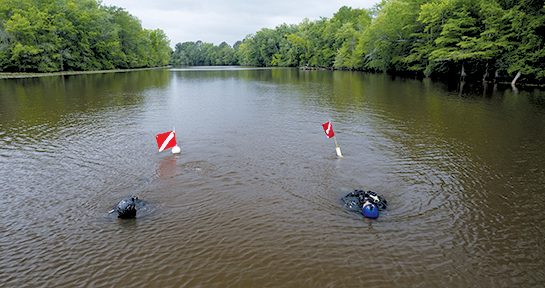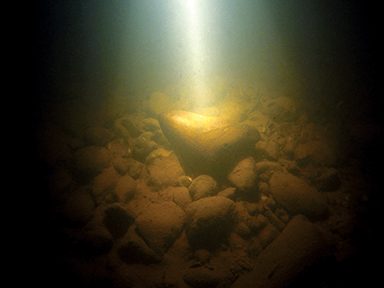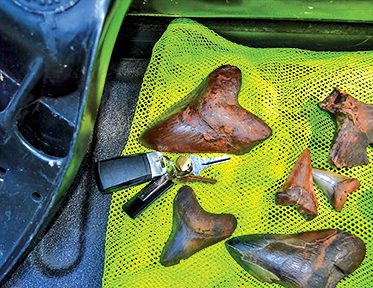MANY DIVERS AND NONDIVERS ALIKE envision the ideal scuba dive as a coral reef in warm, clear water surrounded by a myriad of beautiful fish. River diving, on the other hand, is drastically different and not for the faint of heart.
Limited visibility, underwater obstructions, hazardous wildlife, and potentially remote locations are some of the many challenges for river divers. Limited visibility, however, can be relaxing. By losing a large, encompassing field of view, the diver is forced to concentrate on a smaller area with fewer distractions. Add the potential of finding fossils and other artifacts as well as the personal challenge of becoming proficient in a more difficult environment, and river diving can become a rewarding experience if executed safely.
Basic skills such as proper buoyancy control, propulsion techniques, and trim are key components of safe river diving. Inconsistent buoyancy control can silt out the dive site, and inefficient kick cycles will make working against a current more difficult. Improper trim will cause increased drag and resistance.
As exertion rate increases so will gas consumption. River divers should plan their gas supply requirements using an accurate consumption rate and frequently monitor their levels. Gauges may not always be visible depending on the turbidity of the water.



Configuration
Having confidence in your equipment configuration is necessary. A streamlined configuration minimizes the potential for entanglement and other problems. Any loose or dangling equipment can get damaged or possibly endanger the diver. Eliminate as many buckles and attachment points as possible, and rotate bolt snaps or clips in a direction that reduces the possibility of them catching on an entanglement hazard.
Familiarity with your configuration can also provide confidence in a zero-visibility environment. To be fully prepared for a loss of visibility or light failure, practice your skills and equipment handling while wearing a blackout mask in confined water.
Self-Sufficient Mentality
River divers should be as self-sufficient as possible because traditional buddy-system techniques may not always be feasible and can even increase problems. Visual communication, for example, becomes more difficult as visibility decreases. Tethered divers can use line-pull communication, but lines may increase the risk of entanglement with underwater obstructions.
It takes longer to communicate and respond to problems in low to zero visibility, but the need to act quickly remains the same. If a diver becomes entangled or has another issue, their buddy might not be able to see them or know what’s wrong. River divers need to know how to fix the problem without relying on a buddy’s help or risking their life. Working with the mentality of a solo diver can eliminate the team-related difficulties, but it increases the personal responsibility required to operate independently.
Equipment
Divers must invest in redundant equipment as well as any legally required items. Each person should have a primary light source as well as at least one backup. Spare masks and bump helmets can be beneficial.
River divers should carry at least one cutting device that’s easily accessible yet positioned to reduce the possibility of entanglement. Mesh bags are a necessity if it is legal to take items. A large screwdriver or spike can be useful to anchor yourself in one spot if diving in heavy current. Any accessory added to the equipment configuration, however, solves one problem but adds to the entanglement potential.
A dive flag may not be legally required in all locations, but it’s a prudent addition to your kit. The line reel or finger spool used to deploy the flag will add another dimension to equipment handling and be another possible source of entanglement. Divers must be vigilant to remain within the specified distance of the flag to avoid a costly ticket or potential boat strike. Never assume a boat operator knows what the dive flag signifies, so dive accordingly.
Perform ascents out of the channel if possible. The state agency responsible for wildlife and inland waters where you plan to dive can provide information about the proper regulations.
Navigation
If starting from a fixed position, work into the current. When drift diving, face upstream and let the current carry you down the river. Any silt created will be at your feet, and your fins will contact any obstruction first.
Knowing general information such as tide tables, flow rates, and river orientation will help identify more dangerous areas associated with low- or high-flow situations. When diving in coastal rivers, it is common to experience tidal flow changes and become disoriented. Use both natural and compass navigation techniques, especially if the location has only one safe entry and exit location.
Hazards
Most threats in these environments will not seek out divers, but you may encounter them all at some point. Hazardous animals in and around rivers include alligators, bull sharks, venomous and nonvenomous snakes, large catfish, leeches, crabs, and humans.
Humans tend to be the most dangerous, both in their negligence to personal safety and in the dangers they leave behind. For centuries rivers have been the dumping grounds for trash. Broken bottles, tires, aluminum cans, and other garbage may be strewn on the bottom. Old fishing lines, lures, and hooks may snag or entangle a diver. To help minimize the risk of lacerations, wear cut-resistant gloves in warmer climates.
Erosion is necessary for fossil formation exposure, but it can also create an overhead environment. Overhangs may develop along the outside downstream bend, so closely observe the bank topography.
It’s possible to lose direct access to the surface anywhere in a river. Log jams and other large debris fields can trap a diver. The current will be noticeably slower as you approach a debris pile. Lateral direction shifts to locate unrestricted flow will help you avoid obstructions.
Licenses and Regulations
Without proper licensing in some locations, you may bring home a summons instead of fossils or artifacts. Contact the state agency responsible for archeology and anthropology to determine if a collection license is necessary.
Take precautions to thoroughly investigate the legalities of recovering objects in state waters. Individual states view submerged cultural resources differently. Do not assume the object is legal to take because you found it. As part of the licensing process, at least one eastern seaboard state requires quarterly reports from divers collecting artifacts.
Be prepared to make many unproductive dives to locate an exposed fossil bed. Many river dives are exploratory with the intent to efficiently cover as much ground as possible. Divers should move slowly while carefully scanning the bottom. To increase productivity, be proficient performing search patterns to maximize efficiency.
If you can find the small fossils, you won’t miss the larger teeth. Once you locate productive ground, keeping that location secret is an unfortunate byproduct of the popularity of megalodon teeth and the time invested to locate them.
River diving techniques vary with each body of water — there is no singular approach that will work in all environments. Spending time in the environment and gaining experience are the difference makers.
Despite the rewards of river diving, the risks are numerous, so don’t overlook them — avoid being distracted by the thrill of the hunt. Proper preparation and planning will help minimize dangers and make the dives more enjoyable. As always, know your limitations, and dive within your experience level. AD
© Alert Diver — Q3 2023